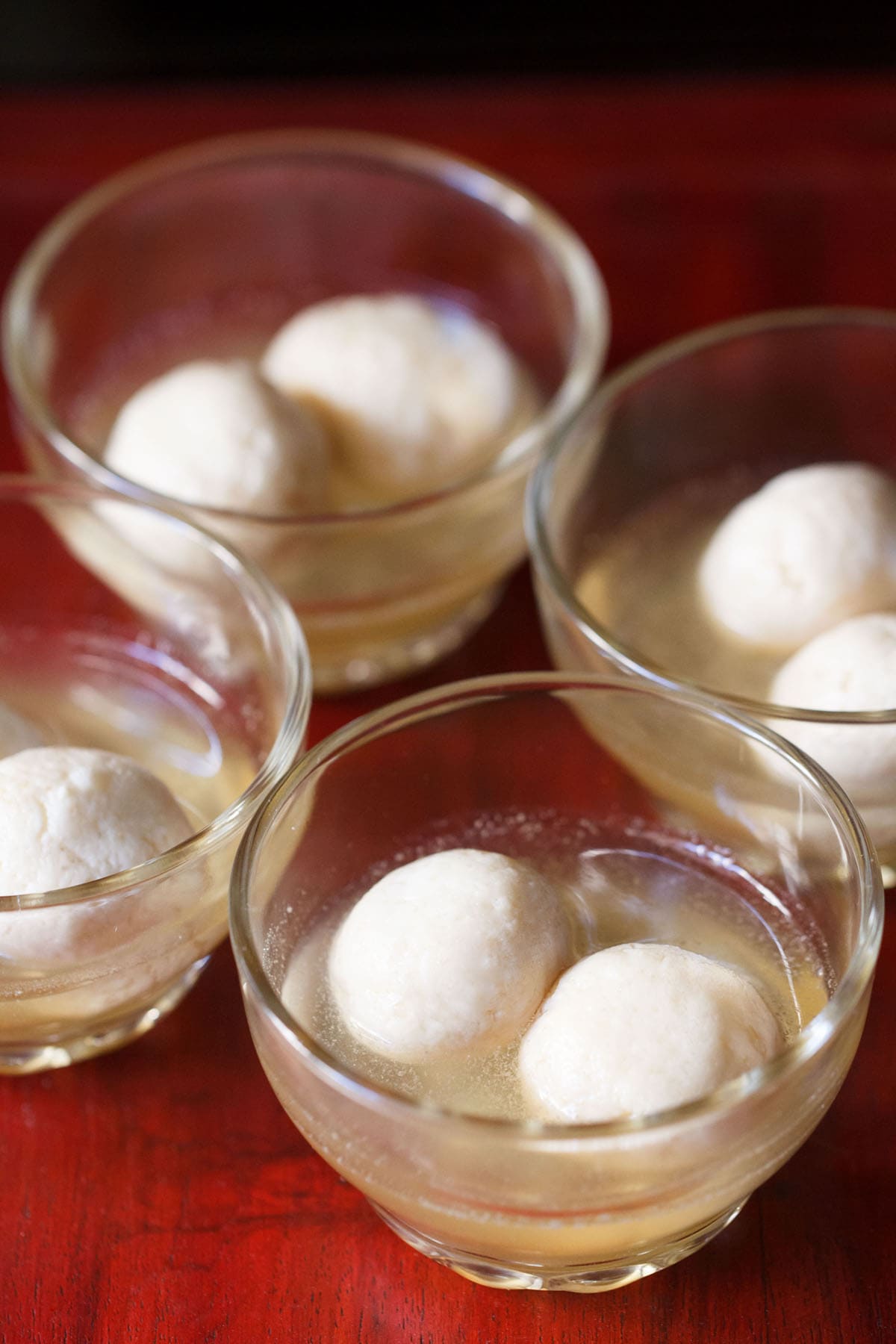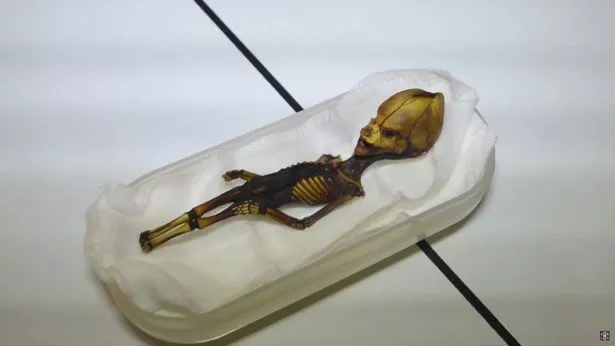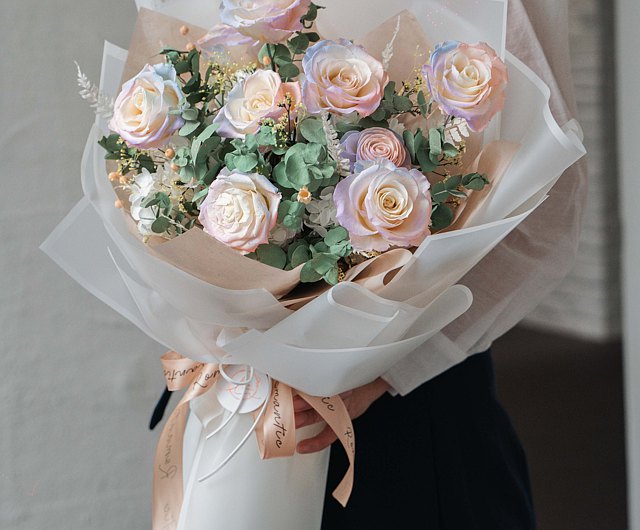Rasgulla Recipe
Written by Sneh Chaudhry on September 1, 2023
Rasgulla is a popular Bengali sweet and is also called rosogolla. This Bengali rasgulla recipe will guide you in making soft and spongy rasgulla.


Ingredients
- 1 litre whole milk
- 2 to 3 tablespoons lemon juice or add as required
- 2 cups sugar or raw sugar
- 1 litre water
- 1 tablespoon milk – optional
- 1 teaspoon sooji (rava or cream of wheat) or all-purpose flour or cornstarch
- 1 to 2 tablespoons rose water or kewra water or ½ teaspoon cardamom powder
Instructions
Making Chenna
-
-
Take milk in a pan and keep it to boil on low to medium heat.
-
I used organic cow milk which does not have much fat. If you use buffalo milk, it has too much of fat and makes a thick layer of malai/cream floating on top. You have to remove the thick layer of malai before you proceed with the making of chenna.
-
So when the milk is heating up, line a strainer or bowl with a cheesecloth or muslin.
-
Keep on stirring the milk at intervals so that the froth is not formed on the top and the base does not get browned or the milk solids get stuck to the bottom.
-
When the milk comes to a boil, then reduce the heat to its lowest. Add 1 to 3 tablespoons lemon juice. First, add 1 tablespoon of lemon juice and stir. If the milk has not curdled completely, then add 1 tablespoon more. Keep the lemon juice handy with you.
-
-
-
Depending on the quality of milk, you may need to add 1 to 3 tablespoons of lemon juice. Stir after adding the lemon juice. Sometimes I added 1 tablespoon of lemon juice and the milk was curdled and sometimes I needed to add 3 tablespoons too. Vinegar also can be added instead of lemon juice.
-
Another option is curd/yoghurt. Add 4 to 5 tablespoons of yoghurt or more if required. With yoghurt, you don’t need to rinse the chenna in the water later.
-
As soon as the milk curdles, switch off the heat. The milk should curdle completely with the green watery whey. If the milk does not curdle, then add ½ to 1 tablespoon of lemon juice.
-
Now pour the curdled milk into the cheesecloth/muslin-lined strainer or bowl.
-
Gather the muslin from the sides and rinse the chenna or coagulated milk very well in running water. This brings down the temperature of the chenna as well as removes the lemony flavour and tangy taste from the chenna.
-
Now squeeze the muslin with your hands very well, so that excess water is drained from the chenna. Remember there should not be excess water or moisture in the chenna as then the rasgulla will break when cooking.
-
Place a heavy weight on the chenna for 7 to 8 minutes. You can also hang the chenna for about 30 minutes.
-
Making Rasgulla Balls
-
-
After 7 to 8 minutes, remove the cheesecloth from the chenna. Note that the chenna should not have too much moisture nor be too dry.
-
Add 1 teaspoon of sooji /semolina. You can also add all-purpose flour (maida). Adding either of them helps to bind the mixture. For a gluten-free option, add cornstarch instead of semolina or all-purpose flour.
-
First, mix the sooji with chenna and then begin to knead.
-
With the heels of your palms mash the chenna and knead. Keep on collecting the chenna from the sides and continue to mash and knead.
-
This kneading process is very important and also decides the texture of chenna. When you feel your palms becoming a bit greasy, it’s time to stop. Just a bit of greasiness is required.
-
Avoid kneading to an extent where the whole chenna becomes greasy. I kneaded for about 10 minutes as I have very light hands. So depending on the quality of chenna and the pressure you apply while kneading, you can take more or less time. Note that the chenna should just begin to get greasy.
-
Knead to a smooth ball of chenna.
-
Now pinch small portions from the chenna and roll them between your palms to a smooth round ball.
-
Prepare all small balls this way. Cover all the chenna balls with a moist muslin or kitchen towel and keep aside.
-
Making Sugar Syrup
-
In a large pan, take 2 cups sugar and 4 cups water.
-
You have to use a large pot or pan so that there is enough space for the rasgulla to cook and increase in size. You can also use a pressure cooker. I used a pot measuring 8.5 inches in diameter and 4.5 in height – a 3.4-litre stainless steel pot.
-
Keep this pan on the stovetop and heat the sugar solution. Stir so that the sugar dissolves. I cooked kneaded the chenna and cooked the sugar syrup simultaneously. You can also do this way.
-
Add 1 tbsp milk and stir. Adding milk helps in removing impurities. If there are no impurities then you don’t need to add milk and directly proceed to step 6
-
Once the sugar solution becomes hot, the impurities begin to float on the top. You can either remove it with a spoon. Or strain the impurities in a cheesecloth/muslin-lined strainer.
-
Now from the purified sugar solution, reserve ½ cup in a cup or mug. This ½ cup of sugar solution will be added to the cooking rasgulla.
-
Reserve another 1 cup of the sugar solution in a serving bowl.
Cooking Rasgulla
-
For the rest of the 2.5 cups of sugar solution, you add it back to the same large pot and bring it to a boil on medium-high heat.
-
Slid the rasgulla gently into the sugar solution.
-
Once all the rasgulla have been added to the sugar solution, shake the pot. Don’t stir the rasgulla with a spoon. Just gently shake the pot.
-
Cover immediately with a lid and let them cook. Keep the heat to a medium or medium-high.
-
After 4 minutes, open the lid and add ¼ cup of the reserved sugar solution. Shake the pan. Adding this reserved sugar solution ensures that the temperature and consistency of the sugar solution are maintained and the sugar does not cook to its thread consistencies.
-
Cover again and continue to cook.
-
After 4 minutes, again add ¼ cup of the reserved sugar solution. Cover and again cook for 2 minutes. I cooked for 10 minutes. The timing will vary depending on the thickness & quality of the pan, the depth of the pan and the heat intensity.
To Check The Doneness Of Rasgulla
-
There are two ways. First place the rasgulla in a bowl or cup of water. If the rasgulla sinks to the bottom it’s cooked.
-
The second method is to press a small portion of the rasgulla with your finger. If the pressed portion bounces back to its original shape, it is cooked
-
Once they are cooked, switch off the heat and keep the pan down on the countertop.
Soaking Rasgulla In Sugar Syrup
-
Now take each rasgulla with a spoon and place it in the bowl containing the 1 cup of sugar solution. Cover and keep aside.
-
Let the sugar solution in which the rasgulla were cooked, become warm. Then add this to the serving bowl containing the rasgulla.
-
Once the whole mixture has cooled down, add 1 to 2 tablespoons of rose water.
-
If you don’t have rose water you can also kewra water (pandanus extract) or ½ tsp cardamom powder. Stir gently and allow them to be soaked in the sugar syrup for 30 minutes.
Serving And Storage Suggestions
-
You can serve the rasgulla now or refrigerate them and serve them later cold or chilled.
-
When serving place the required amount of rasgulla in each serving bowl. Pour a few tablespoons of the sugar syrup in each serving bowl. If you prefer garnish rasgulla with some slivered almonds or pistachios.
-
Keep them covered with the sugar syrup in an air-tight container. Do not store them at room temperature.







